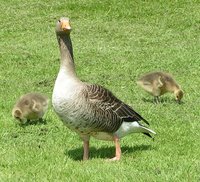Greylag Goose
|
|
| Greylag Goose Conservation status: Secure | ||||||||||||||
|---|---|---|---|---|---|---|---|---|---|---|---|---|---|---|
 | ||||||||||||||
| Scientific classification | ||||||||||||||
| ||||||||||||||
| Binomial name | ||||||||||||||
| Anser anser Linnaeus, 1758 |
The Greylag Goose (Anser anser) is a bird of exceedingly wide range in the Old World, apparently breeding where suitable localities are to be found in most European countries from Lapland to Spain and Bulgaria. Eastwards it extends to China, but does not seem to be known in Japan. It is the type species of the genus Anser. It was once known as the Wild Goose (Anser ferus).
It is the only species indigenous to the British Islands, and in former days bred abundantly in the English Fen country, where the young were caught in large numbers and kept in a more or less reclaimed condition with the vast flocks of tame-bred geese that at one time formed so valuable a property to the dwellers in and around the Fens.
The Greylag is a large goose, with a large head and almost triangular pink or orange-pink bill. The legs are pink, and the bird is easily identified in flight by the pale leading edge to the wing.
It has a loud cackle like the domestic goose.
It is impossible to determine when the wild Greylag Goose ceased breeding in England, but it certainly did so towards the end of the 18th century, for Daniell mentions (Rural Sports, iii. 242) his having obtained two broods in one season. In Scotland this goose continues to breed sparingly in several parts of the Highlands and in certain of the Hebrides, the nests being generally placed in long heather, and the eggs seldom exceeding five or six in number.
It is most likely the birds reared here that are from time to time obtained in England, for at the present day the wild Greylag Goose, though once so numerous, is, and for many years has been, rare in British Islands. Greylags have been reintroduced in many areas of the UK and numbers have increased significantly, however the flocks tend to be semi-tame in these areas. Flocks of Greylags are often mixed with Canada Geese and the two species may interbreed at times.
Origin of Name
The meaning and derivation of this word "lag" had long been a puzzle until Skeat suggested (Ibis, 1870, p. 301) that it signified late, last, or slow, as in laggard, a loiterer, lagman, the last man, lagteeth, the posterior molar or "wisdom" teeth (as the last to appear), and lagclock, a clock that is behind time.
Thus the Greylag Goose is the grey goose which in England, when the name was given, was not migratory but lagged behind the other wild species at the season when they betook themselves to their northern breeding quarters. In connection with this word, however, must be noticed the curious fact mentioned by Rowley (Orn. Miscell., iii. 213), that the flocks of tame geese in Lincolnshire are urged on by their drivers with the cry of "Lag'em, lag'em."
Domestic Geese
The Greylag is the most economically important species of goose, as the origin of the well-known domestic race (see poultry).
The domestication of this species, as Charles Darwin remarks (Animals and Plants under Domestication, i. 287), is of very ancient date, and yet scarcely any other animal that has been tamed for so long a period, and bred so largely in captivity, has varied so little. It has increased greatly in size and fecundity, but almost the only change in plumage is that tame geese commonly lose the browner and darker tints of the wild bird, and are more or less marked with white - being often wholly of that colour.
From the times of the Romans white geese have been held in great estimation, and hence, doubtless, they have been preferred as breeding stock.
The most generally recognized breeds of domestic geese are those to which the distinctive names of Emden and Toulouse are applied; but a singular breed, said to have come from Sevastopol, was introduced into western Europe about the year 1856. In this the upper plumage is elongated, curled and spirally twisted, having their shaft transparent, and so thin that it often splits into fine filaments, which, remaining free for an inch or more, often coalesce again; while the quills are aborted, so that the birds cannot fly.
Importance within Ethology
Lorenz.gif
Within science, the greylag goose is most notable as being the animal with which the ethologist Konrad Lorenz first did his major studying into the behavioural phenomenon of imprinting.
da:Grågås de:Graugans et:Hallhani nl:Grauwe gans pl:Gęś gęgawa zh:灰雁
Categories: Geese | Anser | Poultry
